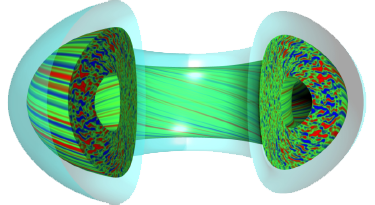Speaker
Description
Previous analyses show that various Alfven Eigenmodes (AEs) can be partially unstable in ITER: energetic particles (EPs), such as fusion-born alpha-particles or neutral beam ions are energetic enough to resonantly interact with these weakly damped plasma waves. Due to the sensitivity of the AEs’ properties on the background kinetic profiles, an automated analysis method is required to study their stability that does not rely upon prior knowledge of the linear mode spectrum, as is the case for most reduced models for EP transport.
In the paper, the first automated time-dependent workflow for energetic particles stability analysis within the Integrated Modelling & Analysis Suite (IMAS) (Python-based) is presented. The workflow orchestrates the retrieval and storage of Interface Data Structures (IDSs) as well as their passing between the physics actors involved: the equilibrium code HELENA and the linear gyro-kinetic stability code LIGKA. In order to demonstrate the capabilities of the workflow, 4 scenarios were chosen from the many available in the ITER - IMAS database. Two of them are time-independent (given by the ASTRA transport code) and two are time-dependent (given by METIS). Both Pre-Fusion Power Operation (PFPO) hydrogen plasmas and Q=10 D-T scenarios are investigated. An analysis of the linear mode properties such as frequency, damping rates and mode structures of various modes present in this scenario is performed to verify and validate various parts of the workflow. A hierarchy of models (analytical, local, global) is employed in sequence, and the results of each model are stored in the IMAS database for documentation and comparison. Fig. 1 shows an example of a series of time-dependent local runs for the two branches (m=21 and 22) of an n=20 TAE: the most unstable phases are expected during ramp-up and ramp-down due to reduced damping during these phases. With the help of the workflow, the calculations can be performed in an automatic way, with controlled input and output in order to ensure reproducibility and consistency. Presently, the WF is also ported to different architectures and various experiments (TCV, ASDEX-Upgrade).
| Country or International Organisation | Germany |
|---|---|
| Affiliation | Max Planck Institute for Plasma Physics |

